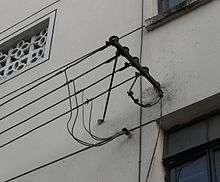Service drop

In electric power distribution, a service drop is an overhead electrical line running from a utility pole, to a customer's building or other premises. It is the point where electric utilities provide power to their customers.[1] The customer connection to an underground distribution system is usually called a "service lateral". Conductors of a service drop or lateral can be owned and maintained by the utility company or by the customer.
At the customer's premises, the wires usually enter the building through a weatherhead that protects against entry of rain and snow, and drop down though conduit to an electric meter which measures and records the power used for billing purposes, then enters the main service panel. The utility's portion of the system ends, and the customer's wiring begins, at the output socket of the electric meter. The service panel will contain a "main" fuse or circuit breaker, which controls all of the electric current entering the building at once, and a number of smaller fuses/breakers, which protect individual branch circuits. There is always a main shutoff switch to turn off all power; when circuit breakers are used this is provided by the main circuit breaker.
Residential
North American
In North America and countries that use their system, the 120/240 V split phase system is used. A pole-mounted distribution transformer usually provides power for one or two residences. The service drop is made up of two 120 V lines and a neutral line. When these lines are insulated and twisted together, they are referred to as a triplex cable which may contain a supporting messenger cable in the middle of the neutral conductor to provide strength for long spans. The neutral line from the pole is connected to a ground near the service panel; often a conductive rod driven into the earth. The service drop provides the building with two 120 V lines of opposite phase, so 240 V can be obtained by connecting a load between the two 120 V conductors, while 120 V loads are connected between either of the two 120 V lines and the neutral line. 240 V circuits are used for high-power devices, such as air conditioners, clothes dryers, ovens and boilers, while 120 V circuits are used for lighter loads such as lighting and ordinary small appliance outlets.
European
In many European countries and other countries that use European systems, three phase service drops are often used for domestic residences. Using three phase power allows longer service drops to serve multiple residences, which is economical with the higher density of housing in Europe. Several slightly different voltage standards have been used: 220Y380, 230Y400 and 240Y415, with plans for future "harmonization" towards 230Y400. The service drop consists of three phase wires and a neutral wire which is grounded. Each phase wire provides around 230 V to loads connected between it and the neutral. Each of the phase wires carries 50 Hz alternating current which is 120° out of phase with the other two. Other countries, such as the UK and Republic of Ireland, generally provide a single phase and neutral per house, with every third house on the same phase. In this case the available current is higher. Single phase supplies with a supplier's fuse of up to 100 A are common, while the 3 phase domestic supplies are generally of lower current rating (often less than 50 A) per phase.
Commercial and industrial
Commercial and industrial service drops can be much bigger, and are usually three phase. In the USA, common services are 120Y/208 (three 120 V circuits 120 degrees out of phase, with 208V line to line), 240 V three phase, and 480 V three phase. 600 V three phase is common in Canada, and 380-415 V or 690 V three phase is found in many other countries. Generally, higher voltages are used for heavy industrial loads, and lower voltages for commercial applications.
Underground
Service conductors for a customer may be run underground, from a padmount transformer to a customer's meter.
References
- ↑ Carson Dunlop "Electrical Systems" Dearborn Real Estate, 2003 ISBN 0-7931-7932-7 page 24